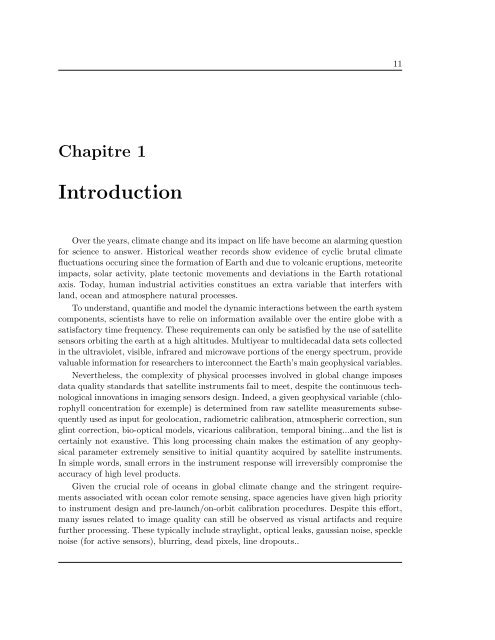Th`ese Marouan BOUALI - Sites personnels de TELECOM ParisTech
Th`ese Marouan BOUALI - Sites personnels de TELECOM ParisTech
Th`ese Marouan BOUALI - Sites personnels de TELECOM ParisTech
You also want an ePaper? Increase the reach of your titles
YUMPU automatically turns print PDFs into web optimized ePapers that Google loves.
11<br />
Chapitre 1<br />
Introduction<br />
Over the years, climate change and its impact on life have become an alarming question<br />
for science to answer. Historical weather records show evi<strong>de</strong>nce of cyclic brutal climate<br />
fluctuations occuring since the formation of Earth and due to volcanic eruptions, meteorite<br />
impacts, solar activity, plate tectonic movements and <strong>de</strong>viations in the Earth rotational<br />
axis. Today, human industrial activities constitues an extra variable that interfers with<br />
land, ocean and atmosphere natural processes.<br />
To un<strong>de</strong>rstand, quantifie and mo<strong>de</strong>l the dynamic interactions between the earth system<br />
components, scientists have to relie on information available over the entire globe with a<br />
satisfactory time frequency. These requirements can only be satisfied by the use of satellite<br />
sensors orbiting the earth at a high altitu<strong>de</strong>s. Multiyear to multi<strong>de</strong>cadal data sets collected<br />
in the ultraviolet, visible, infrared and microwave portions of the energy spectrum, provi<strong>de</strong><br />
valuable information for researchers to interconnect the Earth’s main geophysical variables.<br />
Nevertheless, the complexity of physical processes involved in global change imposes<br />
data quality standards that satellite instruments fail to meet, <strong>de</strong>spite the continuous technological<br />
innovations in imaging sensors <strong>de</strong>sign. In<strong>de</strong>ed, a given geophysical variable (chlorophyll<br />
concentration for exemple) is <strong>de</strong>termined from raw satellite measurements subsequently<br />
used as input for geolocation, radiometric calibration, atmospheric correction, sun<br />
glint correction, bio-optical mo<strong>de</strong>ls, vicarious calibration, temporal bining...and the list is<br />
certainly not exaustive. This long processing chain makes the estimation of any geophysical<br />
parameter extremely sensitive to initial quantity acquired by satellite instruments.<br />
In simple words, small errors in the instrument response will irreversibly compromise the<br />
accuracy of high level products.<br />
Given the crucial role of oceans in global climate change and the stringent requirements<br />
associated with ocean color remote sensing, space agencies have given high priority<br />
to instrument <strong>de</strong>sign and pre-launch/on-orbit calibration procedures. Despite this effort,<br />
many issues related to image quality can still be observed as visual artifacts and require<br />
further processing. These typically inclu<strong>de</strong> straylight, optical leaks, gaussian noise, speckle<br />
noise (for active sensors), blurring, <strong>de</strong>ad pixels, line dropouts..















